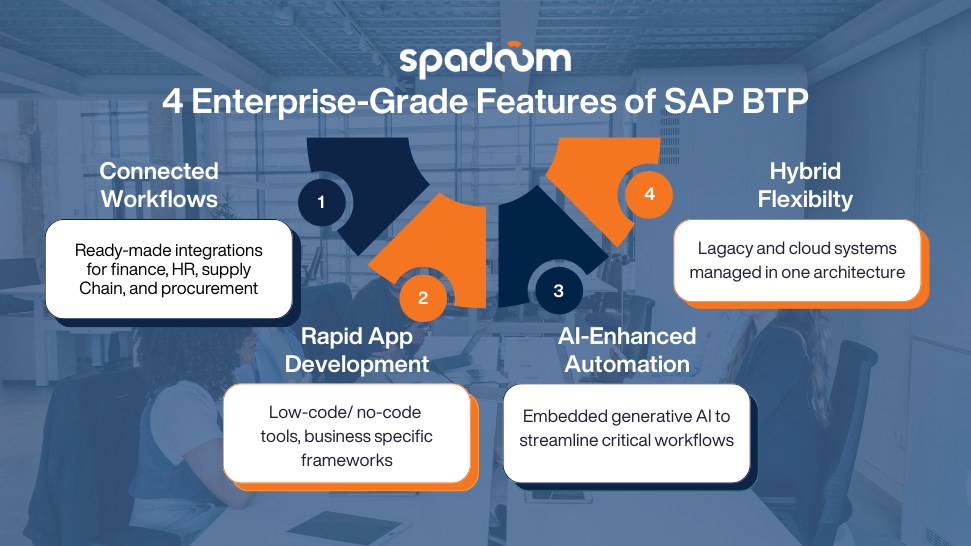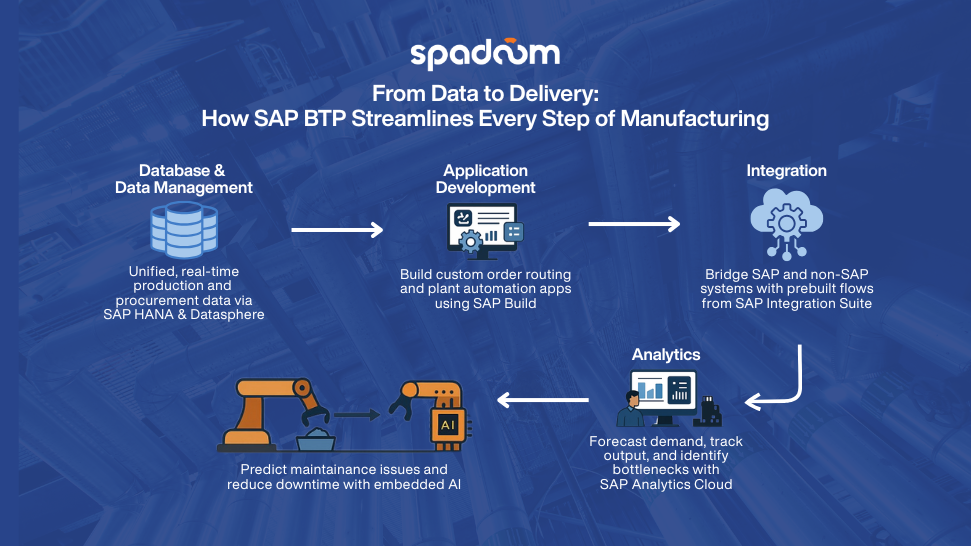With digital expectations rising across every industry, businesses today are expected to be agile, data-driven, and built for resilience. Achieving that trifecta demands more than just modern software; it requires a platform that brings together data, applications, and intelligent technologies in one cohesive system. That’s where SAP Business Technology Platform (SAP BTP) comes in.
With adoption surging by over 60% year-over-year, SAP BTP is now empowering more than 27,000 customers and 2,800 partners worldwide. This momentum is no coincidence—it reflects how integral SAP BTP has become to supporting robust, future-ready SAP architecture strategies and large-scale digital transformation initiatives.
At the heart of SAP BTP are five strategic pillars that shape how organizations harness data, streamline operations, and drive innovation. Whether you’re just exploring the platform or planning a deeper integration, understanding these pillars is essential for unlocking its full potential.
Let’s break down each of these five pillars and explore how they work together to power smarter, more connected businesses.
How SAP BTP Powers End-to-End Digital Transformation for Modern Enterprises
Modern enterprise systems are increasingly complex—built on a mix of cloud services, on-premise tools, and legacy applications. For businesses to innovate at scale, these elements must not only coexist, they must work together.
That’s the strategic value of SAP Business Technology Platform (SAP BTP): it serves as a unifying layer that brings data, application development, integration, and analytics under one architecture, enabling streamlined operations and smarter decisions.
What is SAP BTP?
SAP BTP is a comprehensive technology platform that helps organizations accelerate their digital transformation by providing the tools and services needed to build, enhance, and scale applications across both SAP and non-SAP environments.
Its flexibility supports deployment in public, private, and hybrid cloud environments, tailored to fit evolving SAP architecture strategies.
What are the Key Features of SAP BTP?
Unlike generic cloud platforms, SAP BTP is purpose-built for enterprise-grade scenarios. It enables organizations to:
- Bridge applications across departments with ready-made integrations for finance, supply chain, HR, and procurement.
- Accelerate app development using flexible tools, languages, and business-focused frameworks for all skill levels.
- Harness generative AI to automate tasks and expand mission-critical workflows with minimal coding.
- Support hybrid landscapes, empowering teams to manage both legacy systems and modern cloud solutions within a unified framework.
In 2025, 55% of ASUG (Americas’ SAP Users’ Group) members reported using SAP BTP, and 73% of them are deploying it specifically to support SAP S/4HANA digital transformation projects. This growing adoption shows that SAP BTP is more than a trend—it’s becoming the backbone of modern enterprise solutions.
Whether you’re aiming to build new apps, connect legacy systems, or unlock smarter analytics, SAP BTP offers the structure to evolve your business with confidence.
What are the 5 pillars of SAP BTP?
From streamlining data across platforms to embedding intelligence into everyday workflows, the five pillars of SAP BTP work in sync to modernize how businesses build, connect, analyze, and automate, laying the groundwork for real, measurable digital transformation.
Let’s take a closer look at how each one plays a distinct role in modernizing business architecture.
Data & Analytics
Data is only as valuable as the insights you can draw from it, and that’s exactly where this pillar delivers its strength. Designed to help organizations manage, integrate, and analyze large volumes of data across systems, this layer combines the best of SAP’s database and analytics technologies to power informed, real-time decision-making.
Tools like SAP Datasphere enable seamless data integration and governance across heterogeneous environments, while SAP HANA’s in-memory processing allows companies to analyze large volumes of data on the fly, which isn’t just about speed—it’s about enabling smarter decisions faster.
In fact, businesses using SAP HANA have seen up to a fivefold boost in developer productivity and an 18% improvement in database administration efficiency—a clear sign that SAP BTP services are driving real operational gains.
With analytics deeply embedded into the platform, companies gain more than just visibility—they unlock foresight. SAP Analytics Cloud allows teams to visualize trends, perform predictive analysis, and create intelligent dashboards that support strategic choices across every department.
Key takeaway: By combining high-performance data management with advanced analytics, this pillar helps organizations go beyond storing information. It empowers them to extract meaning, act quickly, and stay responsive in a data-driven world.
Application Development
When speed and adaptability define success, businesses need more than traditional development cycles and rigid coding structures. That’s why SAP BTP’s Application Development pillar is centered on making innovation faster, more accessible, and more aligned with business needs—regardless of technical expertise.
Tools like SAP Build and SAP Business Application Studio are designed for speed and simplicity. They support low-code and no-code development, reusable components, and seamless integrations with existing systems—enabling everyone from professional developers to business users to build apps that solve real problems. Whether it’s automating workflows, digitizing approvals, or customizing customer portals, this pillar reduces the friction between an idea and its execution.
According to Gartner, by 2025, 70% of new business applications will be created using low-code or no-code tools—and SAP is helping businesses stay ahead of that curve. One standout result: companies using SAP Business Application Studio have reported a 48% reduction in customer complaints, driven by faster, more user-centric application updates and issue resolution.
Key takeaway: This pillar empowers businesses to experiment, iterate, and launch solutions faster, removing traditional barriers like long development backlogs or deep coding requirements. The result? Shorter time to value, enhanced customer satisfaction, and a culture of innovation that scales.
Automation
Automation in SAP BTP services is all about working smarter—not harder. This pillar helps businesses reduce manual effort, eliminate repetitive tasks, and streamline complex workflows across departments like HR, finance, and procurement. The goal isn’t just speed—it’s consistency, accuracy, and agility at scale.
Tools such as SAP Build Process Automation and SAP Task Center give teams the ability to build and manage end-to-end processes without writing extensive code. Through Robotic Process Automation (RPA) and intuitive workflow tools, businesses can design intelligent, rule-based systems that run with minimal human intervention.
What further sets this pillar apart is its built-in adaptability. AI-driven automation allows processes to evolve with changing business needs, reacting to real-time data and making smart decisions along the way. This ensures consistent results without bottlenecks, even as operations scale.
Key takeaway: For business leaders, the impact is clear: streamlined operations, fewer errors, and more time for teams to focus on high-value, strategic work. It’s not just about speeding things up, it’s about making your systems work smarter.
Integration
In an era where businesses rely on a mix of cloud, on-premise, and third-party systems, integration isn’t just helpful—it’s critical. The Integration pillar of SAP BTP ensures that all these moving parts work in harmony, allowing companies to deliver seamless workflows and real-time data exchange across their entire landscape.
At the center of this capability is the SAP BTP Integration Suite, which provides a robust framework to connect SAP and non-SAP systems. It supports modern integration patterns such as event-driven architecture, API management, and a rich library of pre-built connectors that eliminate repetitive, time-consuming configurations.
SAP further makes this easier with access to over 2,600 pre-built integration flows, available as part of its business content packs. These ready-to-use templates shorten development time and reduce complexity, allowing teams to focus on results instead of starting from scratch.
Currently, 69% of SAP BTP users leverage its integration capabilities to streamline operations and connect disparate systems, more than any other of its features. This clearly reflects a growing shift toward intelligent, unified infrastructures that minimize silos and maximize agility.
Key takeaway: Effective integration is the difference between systems that coexist and systems that collaborate. Leveraging SAP BTP Integration Suite allows businesses to orchestrate innovation across departments without adding technical debt.
Artificial Intelligence
The AI capabilities embedded in SAP BTP services are designed not to replace existing systems—but to enhance them with intelligence that drives better outcomes. With tools like SAP AI Core, AI Foundation, and the conversational assistant SAP Joule, businesses can bring machine learning and predictive insights directly into the flow of their daily operations.
From forecasting demand to analyzing customer behavior or enabling real-time responses in service processes, AI is built to support—not complicate—mission-critical tasks. It allows teams to automate smarter, act faster, and make decisions grounded in data, not guesswork.
These aren’t theoretical advantages. 44% of current SAP BTP users have stated plans to expand into AI services, showing a clear trend toward operationalizing artificial intelligence across industries.
And because AI is baked into the platform, organizations don’t need to redesign their architecture to benefit. Instead, they can scale intelligence gradually and strategically, embedding smarter decisions into the processes that matter most.
Key takeaway: SAP BTP’s AI isn’t a standalone feature—it’s an operational layer that learns from your data and evolves with your processes. As adoption grows, those who embed AI now gain a compounding advantage in accuracy, efficiency, and forecasting.
How the Pillars Work Together in a Real Business Scenario
Imagine a global manufacturer managing production across multiple regions while facing supply chain disruptions and fluctuating customer demand. With SAP BTP services, the company builds an integrated digital framework that connects departments, systems, and insights—without uprooting its existing SAP infrastructure.
It starts with clean, consistent data managed through SAP HANA Cloud and SAP Datasphere, ensuring every department—from procurement to sales—has access to real-time, accurate information. Using SAP Analytics Cloud, leadership monitors production efficiency and forecasts demand with predictive models.
Meanwhile, the development team uses SAP Build to create custom apps that automate order routing, enabling plants to adjust operations based on local inventory levels. Integration flows from the SAP BTP Integration Suite seamlessly connect legacy ERP systems with modern cloud services, removing bottlenecks in reporting and approvals.
Finally, embedded AI and machine learning detect anomalies in production and suggest proactive maintenance schedules, reducing downtime.
This isn’t a futuristic vision. It’s a practical, achievable model of how SAP BTP’s five pillars collectively drive faster decisions, more agile operations, and truly connected business ecosystems.
Let’s Bring Your SAP Vision to Life with Spadoom
Every transformation journey needs the right foundation—and the right partner. At Spadoom, we help businesses unlock the full potential of SAP BTP by aligning each pillar to your specific goals, systems, and growth plans.
Whether you’re streamlining supply chains, modernizing customer experiences, or building intelligent apps, our team simplifies the complexity of SAP BTP implementation—so you can focus on impact, not infrastructure.
As a trusted provider of SAP consulting for European businesses, we understand regional compliance, industry nuances, and scalability challenges across diverse markets.
Let’s explore how your business can move faster, connect smarter, and innovate confidently with SAP BTP. Contact us today to start your transformation with clarity and confidence.
Frequently Asked Questions (FAQs)
What is the function of SAP BTP?
SAP BTP integrates data, analytics, AI, and app development to streamline business processes. It enables enterprises to extend SAP applications and drive innovation in a unified cloud platform.
Is SAP BTP functional or technical?
SAP BTP is both functional and technical. It offers tools for business users (like low-code apps) and technical users (like APIs, data models, and custom development environments). It bridges IT and business needs.
What are the different types of users in SAP BTP?
SAP BTP defines user types like customer, employee, partner, public, external, and onboardee—each with specific roles and access levels. These categories support both internal and external user management securely.
What language is used in SAP BTP?
SAP BTP supports multiple languages like Java, Node.js, Python, and ABAP, depending on the environment. Developers choose based on Cloud Foundry, Kyma, or ABAP runtime needs.
Is SAP BTP on AWS?
Yes, SAP BTP can be deployed on AWS, as well as other major cloud providers, supporting flexible and scalable cloud infrastructure options for businesses.





